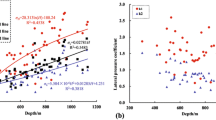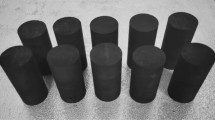Abstract
To explore the differences in deformation failure and energy evolution and simulate the real excavation conditions of coal masses at different depths during the coal-mining process, an unloading failure experiment was conducted. The experiment included coal samples at different depths from the no. 15 coal seam of the Ji group in the Pingmei coal-mining area. The sample depths were 300, 600, 700, 850, and 1050 m. The in situ stress environment, physical rock properties, and excavation disturbance influence were considered in the analysis. The results show that as the depth increases, the peak strength and residual strength of coal samples increase nonlinearly and that the deformation capacity simultaneously increases. The elastic strain energy stored before the unloading of coal, the total energy input, the accumulated elastic energy, and the dissipated energy generated during failure all increase with increasing depth, and the ratios of these results for the 1050–300 m samples were 10.79, 3.75, 3.78, and 4.67, respectively. A prepeak stage energy evolution model was established for coal samples from different depths, and the energy transformation trends of the deformation and failure of coal were explored from the perspective of the energy evolution rate. The energy dissipation efficiency (ued) was defined to represent the energy dissipation generated per unit of energy input. When the energy input is mainly transformed to dissipation energy, the failure of coal occurs (ued > 0.5), and the energy is predominantly associated with crack growth at this point, so the coal is quickly destroyed. This conversion occurs earlier as the depth increases. The AE energy release trend exhibited a good correspondence with the increases in the energy dissipation, dissipation rate, and dissipation efficiency with depth during coal unloading failure, which indicates a more intense failure of the coal body at deeper depths.






















Similar content being viewed by others
Abbreviations
- E u, E 0 :
-
Unloading and initial elasticity modulus, MPa
- v u, v :
-
Unloading and initial Poisson’s ratio, 1
- U :
-
Total input energy, J/m3
- U d :
-
Dissipated strain energy, J/m3
- U e :
-
Elastic strain energy, J/m3
- U 0 :
-
Initial elastic energy, J/m3
- a e, b e, c e, m e :
-
Parameters of elastic energy evolution model, 1
- a d, b d, c d, m d :
-
Parameters of dissipated energy evolution model, 1
- u ed :
-
Efficiency of energy dissipation, 1
- A :
-
Cumulative AE energy, J
- A c :
-
Total amount of cumulative AE energy, J
- σ H :
-
Measured horizontal maximum stress, MPa
- σ h :
-
Measured horizontal minimum stress, MPa
- σ v :
-
Vertical stress, MPa
- σ i :
-
Principal stress (i = 1, 2, 3), MPa
- ε i :
-
Principal strain (i = 1, 2, 3), 1
- ε ei :
-
Elastic strain (i = 1, 2, 3), 1
References
He M, Xie H, Peng S, Jiang Y (2005) Study on rock mechanics in deep mining engineering. Chin J Rock Mech Eng 24(16):2803–2813
Huang D, Li Y (2014) Conversion of strain energy in triaxial unloading tests on marble. Int J Rock Mech Min Sci 66(1):160–168
Jiang HK, Zhang L, Zhou YS (2000) Granite deformation and behavior of acoustic emission sequence under the temperature and pressure condition in different crust depths. Acta Seismol Sin 22(4):395–403
Jing F, Sheng Q, Yu M (2010) The change rule of the geostress and the elastic modulus of rock with depth and their mutual impact. In: The 11th national conference of rock mechanics and engineering 2010, pp 69–74
Kaiser PK, Kim BH (2015) Characterization of strength of intact brittle rock considering confinement-dependent failure processes. Rock Mech Rock Eng 48:107–119
Li P, Wang J (2015) Experimental on mechanical properties of overlying strata rock changed with the occurrence depth. J Harbin Inst Technol 47(12):98–101
Li D, Sun Z, Xie T, Li X, Ranjith P (2017) Energy evolution characteristics of hard rock during triaxial failure with different loading and unloading paths. Eng Geol 228:270–281
Liu Q, Zhang R, Wang M, Wei S, Zhang Z, Gao M, Jia Z, Zhang Z (2017) Physical properties of coal from different depths. J China Coal Soc 42(8):2101–2109
Munson D (1997) Constitutive model of creep in rock salt applied to underground room closure†. Int J Rock Mech Min Sci 34(2):233–247
Sellers E, Klerck P (2000) Modelling of the effect of discontinuities on the extent of the fracture zone surrounding deep tunnels. Tunnel Undergr Sp Technol 15(4):463–469
The Standardization Administration of China (2009) Methods for determining the physical and mechanical properties of coal and rock. Standards Press of China, Beijing
Wu Y (2000) Research on the law of porosity of rock with depth. J Xian Univ Technol 16(1):6–8
Xie H (2017) Research framework and anticipated results of deep rock mechanics and mining theory. Adv Eng Sci 49(2):1–16
Xie H, Peng R, Ju Y (2004) Energy dissipation of rock deformation and fracture. China J Rock Mech Eng 23(21):3565–3570
Xie H, Peng R, Ju Y, Zhou H (2005) On energy analysis of rock failure. Chin J Rock Mech Eng 24(15):2603–2608
Xie H, Ju Y, Li L, Peng R (2008) Energy mechanism of deformation and failure of rock masses. Chin J Rock Mech Eng 27(9):1729–1740
Xie H, Gao F, Ju Y, Gao M, Zhang R, Gao Y, Liu J, Xie L (2015a) Quantitative definition and investigation of deep mining. J China Coal Soc 40(1):1–10
Xie H, Gao F, Ju Y (2015b) Research and development of rock mechanics in deep ground engineering. Chin J Rock Mech Eng 11:2161–2178
Xie J, Gao M, Zhang R, Li S, Tan Q, Qiu Z (2016) Lessons learnt from measurements of vertical pressure at a top coal mining face at datong tashan mines, china. Rock Mech Rock Eng 49(7):2977–2983
Yang SQ, Jing HW, Wang SY (2012) Experimental investigation on the strength, deformability, failure behavior and acoustic emission locations of red sandstone under triaxial compression. Rock Mech Rock Eng 45(4):583–606
Yang SQ, Tian WL, Ranjith PG (2017) Experimental investigation on deformation failure characteristics of crystalline marble under triaxial cyclic loading. Rock Mech Rock Eng 50(11):2871–2889
Zhang Z, Gao F (2012) Research on nonlinear characteristics of rock energy evolution under uniaxial compression. Chin J Rock Mech Eng 6:1198–1207
Zhang R, Dai F, Gao M, Xu N, Zhang C (2015) Fractal analysis of acoustic emission during uniaxial and triaxial loading of rock. Int J Rock Mech Min Sci 79:241–249
Zhang Z, Zhang R, Wu S, Deng J, Zhang Z, Xie J (2018a) The stress sensitivity and porosity sensitivity of coal permeability at different depths: a case study in the pingdingshan mining area. Rock Mech Rock Eng 2018:1–13
Zhang Z, Xie H, Zhang R, Zhang Z, Gao M, Jia Z, Xie J (2018b) Deformation damage and energy evolution characteristics of coal at different depths. Rock Mech Rock Eng 2018:1–13
Zhou H, Xie H, Zuo J, Du S (2010) Experimental study of the effect of depth on mechanical parameters of rock. Chin Sci Bull 55(34):3276–3284
Zuo J, Chai N, Zhou H (2011) Study on the effect of buried depth on failure and energy characteristics of the basalt. Chin J Undergr Sp Eng 7(6):1174–1180
Acknowledgements
The authors are grateful for the financial support from the National Natural Science Foundation of China (nos. 51622402, 51804203, 51804204), the Science and Technology Planning Project of Sichuan Province, China (no. 2017TD0007), and the Fundamental Research Funds for the Central Universities (2012017yjsy170).
Author information
Authors and Affiliations
Corresponding author
Additional information
Publisher's Note
Springer Nature remains neutral with regard to jurisdictional claims in published maps and institutional affiliations.
Rights and permissions
About this article
Cite this article
Jia, Z., Li, C., Zhang, R. et al. Energy Evolution of Coal at Different Depths Under Unloading Conditions. Rock Mech Rock Eng 52, 4637–4649 (2019). https://doi.org/10.1007/s00603-019-01856-y
Received:
Accepted:
Published:
Issue Date:
DOI: https://doi.org/10.1007/s00603-019-01856-y




